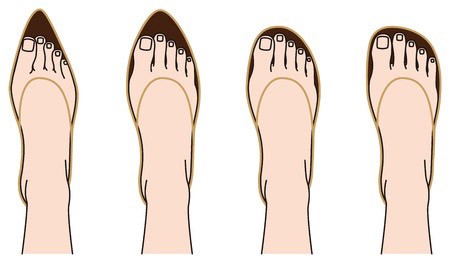Shoes come is all shapes and sizes. From narrow to wide, pointed toe, rounded toe, high heel, flat soled, wedges, slip on, velcro and many more styles and designs. The shape of ones shoe often determines how well it fits and how well it supports foot functionality.
Below is a diagram demonstrating the shape of 4 different styles of shoes.

Images 1 to 3 beginning from the left, show shapes typically seen in women’s shoes (high heels and ballet flats). Most obvious in the far left shoe shape is the bunching of toes and alteration of natural foot shape to fit the shoe. Shoes that constrict the foot in this way can result in the development of the following conditions:
1. Hallux Abducto Valgus (Bunions)
2. Corns and Callus
3. Hammer toes or other digital deformity
4. Tightening of the Achilles tendon
5. Morton’s neuroma
6. Bursitis
Image 4
On the far right shows a shoe shape that allows room for the width and length of the whole foot. An allowance of at least 1cm from the toes to inner end of the shoe is recommended when standing for best fit and support to foot function. This allows the foot to expand and contract as it adapts to the group. Shoes that have a wide and deep toe box, firm heel counter, soft inner sole and tough outer sole with a good fastening are best for comfort and reducing risk of foot pain.
On the far right shows a shoe shape that allows room for the width and length of the whole foot. An allowance of at least 1cm from the toes to inner end of the shoe is recommended when standing for best fit and support to foot function. This allows the foot to expand and contract as it adapts to the group. Shoes that have a wide and deep toe box, firm heel counter, soft inner sole and tough outer sole with a good fastening are best for comfort and reducing risk of foot pain.
If you need any advice or treatment regarding foot pain, please book in with one of our skilled podiatrists today.
Please call us on 8645 9800 or,

